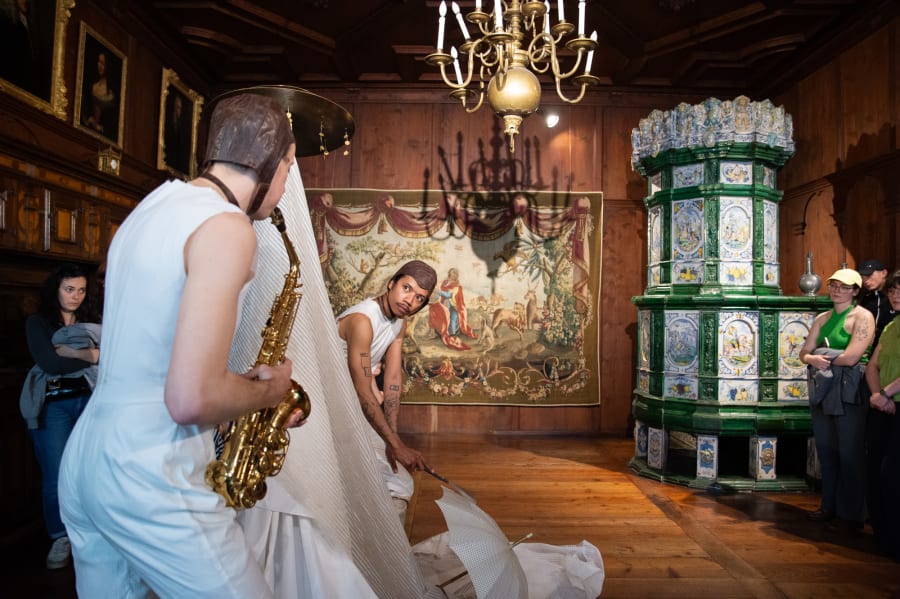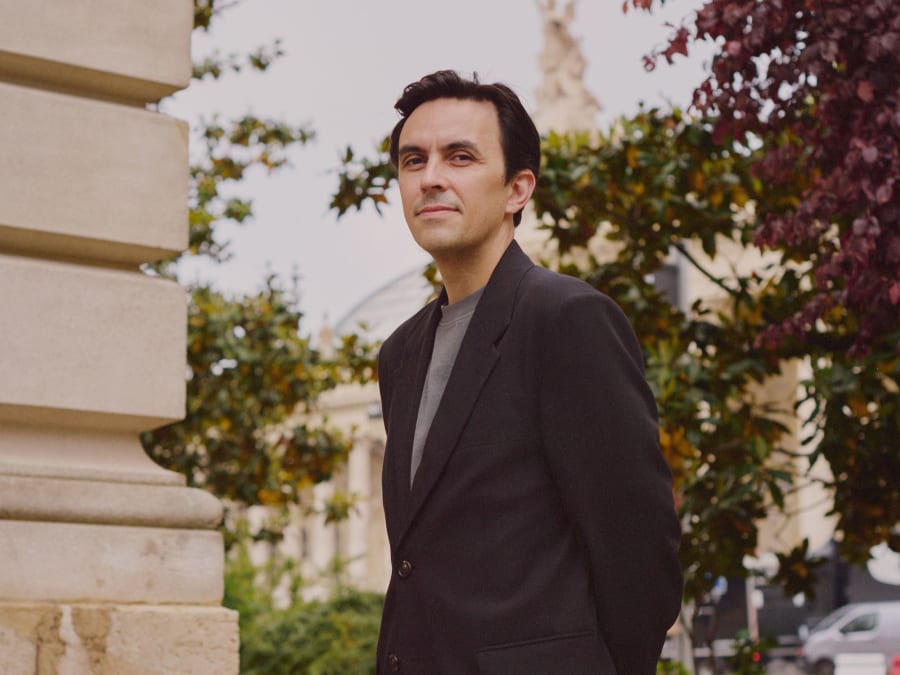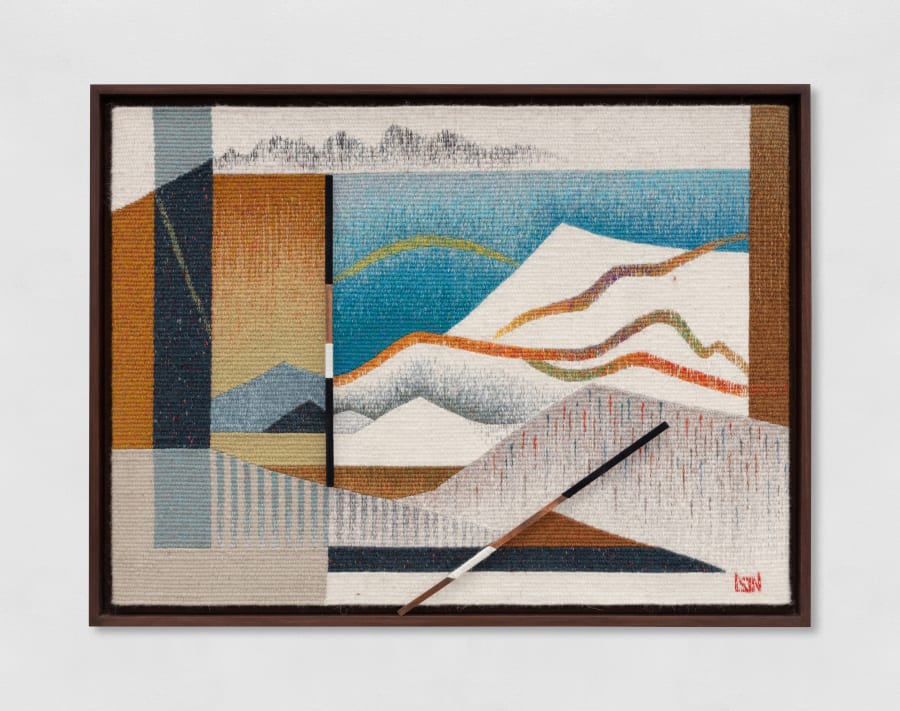When I meet Marie Madec, she is bustling about the office of (sans titre), the gallery she founded six years ago. ‘I spend a lot of time here because it allows me to make the exhibitions my own,’ she says. There is no typical day for her but she prioritizes welcoming the public and maintaining daily contact with her artists. And the young gallerist makes sure she continues to feed her limitless curiosity: ‘In the evenings I go to lots of openings at other galleries. I see two or three exhibitions a week, because art remains my absolute passion.’ The energy that Madec brings to her gallery is immediately palpable: She has an untempered love of creation, preferably the kind that pushes boundaries and is pioneering, and she is friendly without fail.
Madec, a Parisian through and through, has always been drawn to art: ‘As a child, my mother took me to the Louvre once, and then I went back every Wednesday afternoon.’ A childhood obsession with Egyptian archaeology led her to the Sorbonne, where she studied art history and law. Initially she was destined for a career as a teacher-researcher and began a research project on the professionalization of the California art scene in the 1960s, but gradually library shelves gave way to gallery walls. ‘I began frequenting the gallery world more and more because I was also interested in being in contact with my generation,’ she says.
In 2016, she organized her first exhibition in her living room. ‘The idea was to recreate the imaginary apartment of a young collector,’ she remembers. ‘There were artworks, furniture, and old books. Everything that someone who loves contemporary art might possess.’ It marked the beginning of a series of nomadic exhibitions modeled on the idea of a project space – that is, a space with a non-commercial purpose. ‘Over three years I held about ten exhibitions, all in rather atypical places – a former clothing outlet store, a shipyard in Marseille, a crumbling private mansion in the seventh arrondissement of Paris, and even a former restaurant on rue du Vertbois [in the Marais],’ she continues. ‘The concept of each exhibition centered on the history and architecture of each place.’ Thus, (sans titre) established its ethos and, little by little, grew its audience.
‘I realized that, with this model, I couldn’t really support artists with their production,’ she explains. So, in spring 2019, she took the plunge: (sans titre) opened a permanent location in a 25-square-meter space in the 10th arrondissement – in ‘the flowered courtyard of a building that once housed the artists’ entrance to the Théâtre Antoine.’ It was a turning point. Madec invited Eloi Boucher, then a recent graduate of the Villa Arson school of art in Nice, to curate two exhibitions. He went on to join her on her adventure as gallery director. As for the artists, they were inspired by the spirit of the place and staged theatrical installations that were often multidisciplinary: Hamish Pearch and Jessy Razafimandimby both held their first solo shows there.
At the end of the 2010s, Paris was experiencing a moment of transition. ‘I arrived at a rather particular time,’ Madec believes. ‘The golden age of Parisian project spaces was over. Venues like castillo/corrales or Shanaynay no longer existed or had changed their models.’ The same observation applies to galleries. ‘There was a whole wave of spaces that opened 10 to 15 years ago, like Sultana, Crèvecoeur, Balice Hertling, Ciaccia Levi, or, in Belleville, Marcelle Alix and mor charpentier,’ she notes, while pointing out similarities in her trajectory with that of exo exo, a gallery that also grew out of a project-space model and entered the art-fair circuit simultaneously. She continues: ‘Then, a second generation arrived two or three years ago, with Lo Brutto Stahl, Spiaggia Libera, and DS Galerie.’
(sans titre) is today an essential presence on the art scene. Of the 11 artists on its roster, which includes Zuzanna Czebatul, Agnes Scherer, and Tanja Nis-Hansen, who held her third solo show at the gallery this summer, many have been with Madec since the beginning. She is proud of this fact: ‘None of them has left for elsewhere!’ In 2022, the gallery moved to its current space in the Marais, just a stone’s throw from the Centre Pompidou. It quickly settled into its new home, a former drinking establishment with a façade as red as wine and columns topped with Bacchus heads either side of its door – a serendipitous echo of the principles of warmth and hospitality embedded in (sans titre)’s DNA. For the building’s renovation, Madec enlisted the help of a close friend, the architect Maxime Bousquet. In early September, they collaborated once again when he curated the exhibition ‘Le secret des secrets’ during Paris Design Week 2025. The aim was to attract ‘an audience sensitive to art but who don’t necessarily frequent galleries,’ Madec says.
In October, (sans titre) will participate in Art Basel Paris. Its booth will highlight the precarious balance between strength and fragility through the work of five artists: Aysha E. Arar, Czebatul, Pearch, Scherer, and Sequoia Scavullo. Scherer will also exhibit at the gallery during the week of the fair, with an installation that Madec enthusiastically describes as ‘very theatrical and holistic.’
(sans titre) will participate in the Galeries sector of Art Basel Paris 2025, from October 24 to 26, 2025. Get your tickets here.
Ingrid Luquet-Gad is an art critic and PhD candidate based in Paris. She teaches art philosophy at Université Paris 1 Panthéon-Sorbonne.
Caption for header image: Marie Madec in front of her gallery, (sans titre). Photograph by Matthieu Croizier for Art Basel.
English translation: Art Basel.
Published on September 26, 2025.


